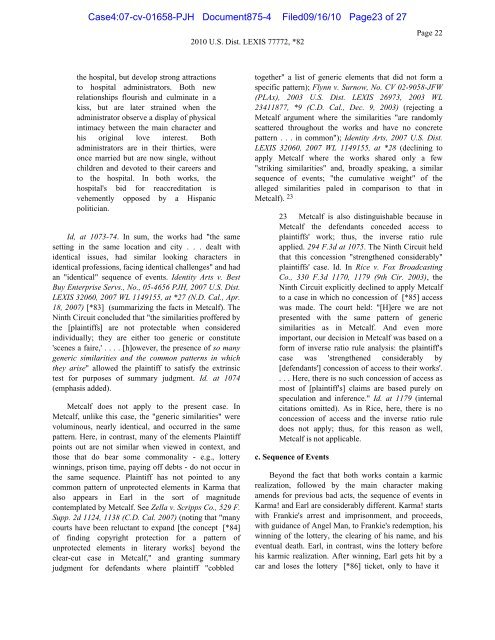exhibit 2 - SAP Lawsuit Portal
exhibit 2 - SAP Lawsuit Portal
exhibit 2 - SAP Lawsuit Portal
Create successful ePaper yourself
Turn your PDF publications into a flip-book with our unique Google optimized e-Paper software.
Case4:07-cv-01658-PJH Document875-4 Filed09/16/10 Page23 of 27<br />
the hospital, but develop strong attractions<br />
to hospital administrators. Both new<br />
relationships flourish and culminate in a<br />
kiss, but are later strained when the<br />
administrator observe a display of physical<br />
intimacy between the main character and<br />
his original love interest. Both<br />
administrators are in their thirties, were<br />
once married but are now single, without<br />
children and devoted to their careers and<br />
to the hospital. In both works, the<br />
hospital's bid for reaccreditation is<br />
vehemently opposed by a Hispanic<br />
politician.<br />
Id, at 1073-74. In sum, the works had "the same<br />
setting in the same location and city . . . dealt with<br />
identical issues, had similar looking characters in<br />
identical professions, facing identical challenges" and had<br />
an "identical" sequence of events. Identity Arts v. Best<br />
Buy Enterprise Servs., No., 05-4656 PJH, 2007 U.S. Dist.<br />
LEXIS 32060, 2007 WL 1149155, at *27 (N.D. Cal., Apr.<br />
18, 2007) [*83] (summarizing the facts in Metcalf). The<br />
Ninth Circuit concluded that "the similarities proffered by<br />
the [plaintiffs] are not protectable when considered<br />
individually; they are either too generic or constitute<br />
'scenes a faire,' . . . . [h]owever, the presence of so many<br />
generic similarities and the common patterns in which<br />
they arise" allowed the plaintiff to satisfy the extrinsic<br />
test for purposes of summary judgment. Id. at 1074<br />
(emphasis added).<br />
Metcalf does not apply to the present case. In<br />
Metcalf, unlike this case, the "generic similarities" were<br />
voluminous, nearly identical, and occurred in the same<br />
pattern. Here, in contrast, many of the elements Plaintiff<br />
points out are not similar when viewed in context, and<br />
those that do bear some commonality - e.g., lottery<br />
winnings, prison time, paying off debts - do not occur in<br />
the same sequence. Plaintiff has not pointed to any<br />
common pattern of unprotected elements in Karma that<br />
also appears in Earl in the sort of magnitude<br />
contemplated by Metcalf. See Zella v. Scripps Co., 529 F.<br />
Supp. 2d 1124, 1138 (C.D. Cal. 2007) (noting that "many<br />
courts have been reluctant to expand [the concept [*84]<br />
of finding copyright protection for a pattern of<br />
unprotected elements in literary works] beyond the<br />
clear-cut case in Metcalf," and granting summary<br />
judgment for defendants where plaintiff "cobbled<br />
2010 U.S. Dist. LEXIS 77772, *82<br />
together" a list of generic elements that did not form a<br />
specific pattern); Flynn v. Surnow, No. CV 02-9058-JFW<br />
(PLAx), 2003 U.S. Dist. LEXIS 26973, 2003 WL<br />
23411877, *9 (C.D. Cal., Dec. 9, 2003) (rejecting a<br />
Metcalf argument where the similarities "are randomly<br />
scattered throughout the works and have no concrete<br />
pattern . . . in common"); Identity Arts, 2007 U.S. Dist.<br />
LEXIS 32060, 2007 WL 1149155, at *28 (declining to<br />
apply Metcalf where the works shared only a few<br />
"striking similarities" and, broadly speaking, a similar<br />
sequence of events; "the cumulative weight" of the<br />
alleged similarities paled in comparison to that in<br />
Metcalf). 23<br />
23 Metcalf is also distinguishable because in<br />
Metcalf the defendants conceded access to<br />
plaintiffs' work; thus, the inverse ratio rule<br />
applied. 294 F.3d at 1075. The Ninth Circuit held<br />
that this concession "strengthened considerably"<br />
plaintiffs' case. Id. In Rice v. Fox Broadcasting<br />
Co., 330 F.3d 1170, 1179 (9th Cir. 2003), the<br />
Ninth Circuit explicitly declined to apply Metcalf<br />
to a case in which no concession of [*85] access<br />
was made. The court held: "[H]ere we are not<br />
presented with the same pattern of generic<br />
similarities as in Metcalf. And even more<br />
important, our decision in Metcalf was based on a<br />
form of inverse ratio rule analysis: the plaintiff's<br />
case was 'strengthened considerably by<br />
[defendants'] concession of access to their works'.<br />
. . . Here, there is no such concession of access as<br />
most of [plaintiff's] claims are based purely on<br />
speculation and inference." Id. at 1179 (internal<br />
citations omitted). As in Rice, here, there is no<br />
concession of access and the inverse ratio rule<br />
does not apply; thus, for this reason as well,<br />
Metcalf is not applicable.<br />
c. Sequence of Events<br />
Page 22<br />
Beyond the fact that both works contain a karmic<br />
realization, followed by the main character making<br />
amends for previous bad acts, the sequence of events in<br />
Karma! and Earl are considerably different. Karma! starts<br />
with Frankie's arrest and imprisonment, and proceeds,<br />
with guidance of Angel Man, to Frankie's redemption, his<br />
winning of the lottery, the clearing of his name, and his<br />
eventual death. Earl, in contrast, wins the lottery before<br />
his karmic realization. After winning, Earl gets hit by a<br />
car and loses the lottery [*86] ticket, only to have it


